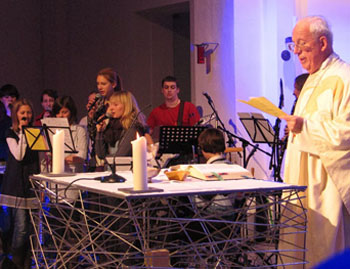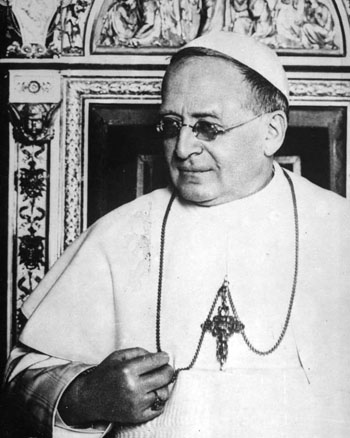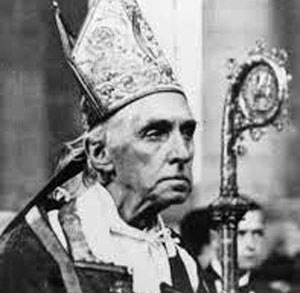Traditionalist Issues
 |
 |
 |
 |
 |
 |
 |
Dialogue Mass - VII
Pius XI vs St. Pius X on Active Participation
In an attempt to justify their preference for congregational singing and spoken responses in the liturgy, opponents of silent prayer invariably mention the Italian version of Pope Pius X’s 1903 motu proprio Tra le Sollecitudine on Sacred Music, which contained the phrase “active participation.” As we have seen previously, this phrase presents two major obstacles to our acceptance of it at its face value.
First, no equivalent expression of this phrase is contained in the only authoritative version of the document, which is the Latin one. There is no reference whatsoever to “active” in that original. Second, there is no reference whatsoever to vocal response from the laity, whether spoken or sung.
Where did the expression ‘active participation’ come from?
If we examine the major documents on the liturgy issued by Pius X anterior to his pontificate, one fact imposes itself: “active participation” was never part of his lexicon.
 We can show by means of these texts the continuity and remarkable consistency of his thought on the liturgy:
We can show by means of these texts the continuity and remarkable consistency of his thought on the liturgy:
It is also worth remembering that no mention of “active participation” was made in the 1917 Code of Canon Law which had been drawn up under Pius X.
Pius XI’s progressist legislation
With the publication of the Apostolic Constitution Divini Cultus (1928), there is no doubt that the Liturgical Movement started to slide dramatically in the direction of Vatican II. In it, Pope Pius XI specifically recommended the “active participation” of the congregation in the liturgy:
“In order that the faithful may more actively participate in divine worship, let them be made once more to sing the Gregorian Chant, so far as it belongs to them to take part in it.”
 This marks a distinct break with his predecessor’s position. St. Pius X had never allotted a role for the congregation to sing Gregorian Chant or even suggested that “it belongs to them to take part in it.” On the contrary, St. Pius X had said the opposite. He indicated that members of the congregation are not included in this form of participation when he said that, apart from what is sung by the celebrant and his ministers at the altar, all the rest of the liturgical chant belongs to the choir. (4)
This marks a distinct break with his predecessor’s position. St. Pius X had never allotted a role for the congregation to sing Gregorian Chant or even suggested that “it belongs to them to take part in it.” On the contrary, St. Pius X had said the opposite. He indicated that members of the congregation are not included in this form of participation when he said that, apart from what is sung by the celebrant and his ministers at the altar, all the rest of the liturgical chant belongs to the choir. (4)
How anyone who has read the document could, with a clear conscience, interpret this as a desire on the part of the Pope for congregational singing takes some explaining.
Another glaring anomaly in Divini Cultus is the following statement:
“It is most important that when the faithful assist at the sacred ceremonies, or when pious sodalities take part with the clergy in a procession … they should sing alternately with the clergy or the choir …whether in the language of the Liturgy or in the vernacular.”
In this passage, where the congregation is actually instructed to sing the responses, confusion reigns between liturgical and non-liturgical situations. The concept of sacred ceremonies may apply to both ceremonies outside and inside the church and, therefore, the laity is indirectly invited by Pius XI to sing inside the church during sacred ceremonies.
However, St. Pius X had made a crucial distinction between ceremonies that take place inside the church and religious events that take place outside the church, such as processions, pilgrimages etc. In the former case, singing is a strictly liturgical function reserved for the clergy and choir; in the latter, all the faithful were permitted to sing hymns in any language. (5)
Behind the scenes lobbying
What is not always appreciated about Divini Cultus is the fact that, prior to its publication, a robust lobbying operation had been going on in the Vatican to achieve the goal of “active participation” in the liturgy.
 Pius XI admitted that he was being influenced by lobbyists: “We are thus acceding to the requests which … have been made to Us” by “not a few Bishops” and various “musical congresses.”
Pius XI admitted that he was being influenced by lobbyists: “We are thus acceding to the requests which … have been made to Us” by “not a few Bishops” and various “musical congresses.”
This shows that the progressivist foxes were already sniffing around the Vatican hen house, waiting for someone to lift the latch. No names of the Bishops are given, but officially published documents give us a glimpse of some of them, including Beauduin’s protector, Card. Mercier of Malines. (6)
As an ardent supporter of Beauduin’s Liturgical Movement, Card. Mercier had, according to his biographer, “made every possible effort to introduce the practice of congregational singing into his diocese” long before Divini Cultus was published. (7)
So, as far as “active participation” is concerned, it was not exactly the Church speaking, but a handful of agenda-driven enthusiasts clamouring for policy changes who had gained the ear of the Pope.
Continued

Posted June 4, 2014
First, no equivalent expression of this phrase is contained in the only authoritative version of the document, which is the Latin one. There is no reference whatsoever to “active” in that original. Second, there is no reference whatsoever to vocal response from the laity, whether spoken or sung.
Where did the expression ‘active participation’ come from?
If we examine the major documents on the liturgy issued by Pius X anterior to his pontificate, one fact imposes itself: “active participation” was never part of his lexicon.

A choir composed by young men and women performs at the altar - a consequence of active participation
- In 1888, when he was Bishop of Mantua, he held a Synod that issued various decrees on pastoral topics, including the liturgy. The decrees on Sacred Music concerned Gregorian Chant, the use of musical instruments, the choice of organ music, the training of seminarians and the exclusion of women from church choirs. The topic of “active participation” was entirely absent.
- In 1893, as Cardinal Patriarch of Venice, he sent a detailed report called a Votum to the Sacred Congregation of Rites after Pope Leo XIII had organized a Conference on Gregorian Chant and issued a papal questionnaire
In the Votum, which can be read here, (1) he set out the Church’s official teaching on Sacred Music. This basically followed the principles of Pope Leo XIII’s earlier document, Ordinatio quoad sacram musicam, on Sacred Music issued in 1884. (2) It is significant that the Votum had been drawn up by Fr. Angelo De Santi, who would later prepare the content of Pius X’s motu proprio on Sacred Music. The records plainly show that in their respective documents neither Pope nor Cardinal alluded to “active participation.” - In 1895, he issued a pastoral Letter on Sacred Music. It is virtually a reprise of his earlier theme as it reiterates all the points set out in the 1888 Synod and the 1893 Votum. Again, there is no mention of “active participation.”
It is also worth remembering that no mention of “active participation” was made in the 1917 Code of Canon Law which had been drawn up under Pius X.
Pius XI’s progressist legislation
With the publication of the Apostolic Constitution Divini Cultus (1928), there is no doubt that the Liturgical Movement started to slide dramatically in the direction of Vatican II. In it, Pope Pius XI specifically recommended the “active participation” of the congregation in the liturgy:
“In order that the faithful may more actively participate in divine worship, let them be made once more to sing the Gregorian Chant, so far as it belongs to them to take part in it.”

Pius XI, influenced by the modernists, initiates lay participation
How anyone who has read the document could, with a clear conscience, interpret this as a desire on the part of the Pope for congregational singing takes some explaining.
Another glaring anomaly in Divini Cultus is the following statement:
“It is most important that when the faithful assist at the sacred ceremonies, or when pious sodalities take part with the clergy in a procession … they should sing alternately with the clergy or the choir …whether in the language of the Liturgy or in the vernacular.”
In this passage, where the congregation is actually instructed to sing the responses, confusion reigns between liturgical and non-liturgical situations. The concept of sacred ceremonies may apply to both ceremonies outside and inside the church and, therefore, the laity is indirectly invited by Pius XI to sing inside the church during sacred ceremonies.
However, St. Pius X had made a crucial distinction between ceremonies that take place inside the church and religious events that take place outside the church, such as processions, pilgrimages etc. In the former case, singing is a strictly liturgical function reserved for the clergy and choir; in the latter, all the faithful were permitted to sing hymns in any language. (5)
Behind the scenes lobbying
What is not always appreciated about Divini Cultus is the fact that, prior to its publication, a robust lobbying operation had been going on in the Vatican to achieve the goal of “active participation” in the liturgy.

Card. Mercier, an ardent support of the new liturgical movement
This shows that the progressivist foxes were already sniffing around the Vatican hen house, waiting for someone to lift the latch. No names of the Bishops are given, but officially published documents give us a glimpse of some of them, including Beauduin’s protector, Card. Mercier of Malines. (6)
As an ardent supporter of Beauduin’s Liturgical Movement, Card. Mercier had, according to his biographer, “made every possible effort to introduce the practice of congregational singing into his diocese” long before Divini Cultus was published. (7)
So, as far as “active participation” is concerned, it was not exactly the Church speaking, but a handful of agenda-driven enthusiasts clamouring for policy changes who had gained the ear of the Pope.
Continued
- The text is reproduced in Pierre Combe, The Restoration of Gregorian Chant, Catholic University of America Press, 2008, Appendix III, p, 421
- Sacred Congregation of Rites, Ordinatio quoad sacram musicam, ASS, 1884, vol. 17, pp. 340-349.
- Pius X, 1903 motu proprio, # 25: “Let the above-mentioned traditional Gregorian chant be cultivated by all with diligence and love, according to the Tridentine prescriptions.”
- Pius X, motu proprio, 1903, # 12: Praeter melodias celebrantis ad altare et ministrorum, quae cantu gregoriano semper cani debent sine organi sequentia, quae cantus liturgici extant sunt Chori Levitarum. (Apart from the singing of the celebrant at the altar and of his ministers, which must always be sung in Gregorian chant and without accompaniment of the organ, what remains of the liturgical chant belongs to the choir of Levites.)
- Pius X, motu proprio, 1903, # 21: “In processions outside the church, the Ordinary may give permission for a band … to accompany some spiritual canticle sung in Latin or in the vernacular by the singers and the pious associations that take part in the procession.”
Also, lay people were permitted to sing hymns in any language inside the church at non-liturgical ceremonies such as novenas, sodalities, stations of the Cross etc. - The Sacred Congregation of Rites responded in private letters to the Bishops of Mantua (18 Feb. 1921); Pesaro, Italy, (25 Feb. 1921); Malines (27 April 1921); unnamed (4 Aug. 1922); and Genoa (30 November 1935), to say that lay responses in the liturgy are considered “not expedient,” that the custom of silent participation should be respected, and that the issue is for the local Bishops to decide. (See T. L. Bouscaren, The Canon Law Digest, Vol. II, 1933-1942, Bruce, 1943, pp. 198-200).
- A. Laveille, A Life of Cardinal Mercier, trans. Arthur Livingstone, The Century Co., New York, 1928, p. 141

Posted June 4, 2014
______________________
______________________
 Volume I |
 Volume II |
 Volume III |
 Volume IV |
 Volume V |
 Volume VI |
 Volume VII |
 Volume VIII |
 Volume IX |
 Volume X |
 Volume XI |
 Special Edition |


